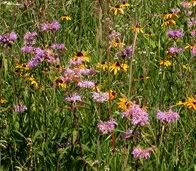From Explorers’ Texas: The Lands and Waters by Del Weniger:
"The most variegated carpet of flowers I ever beheld lay unrolled before me – red, yellow, violet, blue, every color, every tint was there… The finest artificial garden in the world would sink into insignificance when compared with this parterre of nature’s own planting."
“My horse could scarcely make his way through the wilderness of flowers, and I for a time remained lost in admiration of this scene of extraordinary beauty. The prairie in the distance looked as if clothed with rainbows that waved to and fro over its surface.” – Charles Sealsfield in the tallgrass prairies of Texas, 1843






 The
The  Butterflies like the Monarch have always been one of my favorite parts of the prairie.
Butterflies like the Monarch have always been one of my favorite parts of the prairie.